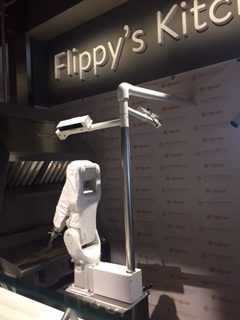
“Have you heard about Flippy?”
That’s what my colleague and fellow Right By the Bay contributor Rowena Itchon asked me recently. I hadn’t…so I Googled it.
Flippy is a burger-flipping robot designed to operate alongside human workers in commercial kitchens. The machine, which costs between $60,000 and $100,000, depending on its features, uses built-in sensors and cameras to locate burger patties on the grill and flip them when necessary. Flippy’s human co-workers are still required to take care of everything else – including topping the patties with cheese and adding lettuce, tomato, and other condiments.
For two days this month, customers at CaliBurger’s Pasadena location were able to enjoy hamburgers prepared by Flippy. The robot debuted to much fanfare and attracted significant media attention. Cali Group, which runs the burger chain, decided to temporarily take Flippy offline after the robot’s human colleagues weren’t able to keep up with preparing the patties, USA Today reported. Flippy is apparently capable of flipping as many as 2,000 burgers a day.
Many fast food companies have been making significant investments in automation in recent years. McDonald’s has been rolling out self-order kiosks in thousands of stores. San Diego-based Jack in the Box’s CEO said the fast-food chain is considering adding automated technology in response to minimum wage hikes in California. Zume Pizza, a Mountain View-based chain already uses robots named Pepe, Giorgio, Marta, Bruno, and Vincenzo to make pizza.
The fast food industry’s embrace of automation is not surprising. As prices for robots and other automated technologies drop, more and more companies will likely add tools like Flippy to their kitchens. And as technology improves, robots will be able to handle even more complex tasks.
To be sure, the benefits of Flippy are many. Robots do not need a paycheck, health insurance, or workers’ compensation insurance. Although they might malfunction or require maintenance (as in the case of Flippy at CaliBurger in Pasadena), they don’t get distracted while working, call out sick, go on strike, sexually harass others, or otherwise cause problems for their employer.
Many conservatives argue that the rise of Flippy (and other examples of workplace automation) is the direct result of minimum wage laws. In California, where the state minimum wage will reach $15 an hour by 2022, adopting automated solutions is a no-brainer for businesses. As a recent Investor’s Business Daily editorial put it, “Flippy doesn’t just flip hamburgers, he exposes why raising the minimum-wage hurts workers.”
But are opponents of minimum wage hikes missing the bigger picture with Flippy? As RealClearMarkets editor John Tamny points out, CaliBurger executives said that they decided to look for an automated solution after struggling with the high turnover of restaurant workers. They are not alone. In September 2016, turnover of U.S. restaurant workers reached an all-time high of 113 percent, according People Report, an industry tracker.
Tamny argues that while it might be tempting for free-marketeers to use Flippy to taunt Bernie Sanders and his “Fight for $15” supporters, we should also recognize that turnover is very expensive for businesses of all stripes – and that automation is a natural response to turnover, which would be even worse if there was no minimum wage. Tamny says that rather than demanding a $15 hourly wage, low-wage workers should be embracing automation.
“That robots are job-destroyers speaks to their genius,” Tamny writes. “Robots have the potential to destroy the entry-level jobs that workers plainly don’t want. If robots can erase what’s not desired, they won’t erase work as much as the definition of ‘entry level’ will change. And it will change for the better as first-time jobs involve the exhibition of more in the way of skills, all at higher pay.”
Tamny makes an important point. Entry-level workers are paid low wages in part because their employers understand that they will eventually leave for better-paying jobs after attaining skills and knowledge through employer-provided training and experience. If automation can help redefine entry-level work to the benefit of entry-level workers, everyone wins, right?
The concern that robots are taking away jobs from individuals dependent upon entry-level work to make ends meet is valid. One thing, however, is certain: automation is here to stay. So, while it’s important to continue making the case against job-killing minimum wage hikes, all Americans would benefit if both the left and the right stopped trying to score political points in the “wage vs. robot” debate and instead engaged in serious conversations about the future of work and the policy impacts of automation.
In the meantime, I look forward to seeing Flippy in action at CaliBurger – or another restaurant – in the near future. Hopefully next time its human co-workers will be able to keep up.
Ben Smithwick is Director of Development for the Pacific Research Institute. Prior to joining PRI, he worked at Fox News Channel’s Los Angeles bureau and for the Santa Barbara News-Press.

